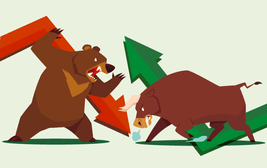When investing in stocks, we often hear about two concepts "Bull Market" and "Bear Market" in technical analysis articles. So what is the concept of “Bull Market” and “Bear Market” as well as the causes of these two markets? In this article, PHS will give some analysis for you to understand better.
What is a Bull Market?
The characteristic of a bull's attack is to raise its horns high, pointing straight ahead. Like the uptrend of the market graph. Therefore, the period of the bull market is called the “Bull Market”.
A Bull Market (bull market) is a period where most investors are buying instead of selling. Demand is greater than supply. Market confidence is high and asset prices are strong. Optimistic green color covered the market, good news spread everywhere.
As investor confidence increases, the more they buy, the more prices rise. This attracts other investors to invest more as well, causing prices to continue to rise and the market to continue to attract new investors.
Why do bull markets happen?
The stock price is a reflection of the future expectations of cash flows that are the profits of the companies involved. When growth prospects are optimistic, future expectations about the business or the economy will develop, the stock price will increase. In the process, buying behavior to hold good stocks to increase the return on investment will help the market go up.
The reasons for the bull market are often different. In general, when the economy is growing steadily or the prospect is attractive, science and technology goes up, peace, political stability can all be the causes leading to the bull market.
Stages of the Bull market
- The first phase is characterized by low prices and positive market sentiment. At the end of this period, many new traders will start entering the market.
- The second phase will see the price begin to rise sharply. At the same time, the transactions and profits of the company or exchange also increase.
- The third stage is when speculators begin to pull out of the market. This leads to a slight decrease in price and trading volume.
- In the final stage, the price will continue to increase, but the rate will slow down. Bad news begins to attract traders to withdraw from the market, the Bull Market gradually turns into a Bear Market.
What Should Investors Do in a Bull Market?
Understanding the market
The price of a given cryptocurrency is significantly influenced by public confidence and sentiment in that asset. Capturing the appearance of the Bull market helps investors determine the level of market optimism (determining market sentiment). Instead of immersing in the general sentiment of the market, investors should practice recognizing possible psychological patterns, thereby helping to make objective and sober decisions more than the majority.
Avoid the FOMO mentality
In the Bull market, investors are usually very optimistic about the price going up further. This leads to FOMO psychology, making it easy for investors to buy continuously and neglect risk control and capital control.
Remember that although the market is rising, it will never go up forever, because liquidity is always cyclical and the market can plummet at any time. Therefore, investors should clearly define investment goals, control greed and fear to avoid "high enough".
What is a Bear Market?
The bear's attack characteristic is to slam its claws down on its enemies. Like the downward trend of the market graph. Therefore, the period of a bear market is called a “Bear Market”.
A Bear Market (bear market) is a period in which the majority of investors are selling. Supply was greater than demand, selling overpowered buying, causing red to cover the market. The majority of investors lost confidence in the market. Bear markets are quite difficult to trade compared to Bull markets, especially for less experienced traders.
Causes of a Bear Market
The stock price is a reflection of the future expectations of the cash flows and profits of the companies involved. When growth prospects weaken, future expectations about businesses or the economy collapse, stock prices fall. In the process, the herding behavior of FOMO (Fear of Missing Out Effect) protects investments during widespread fear, leading to mass sell-offs.
The causes of a bear market are often different. In general, when the economy is in recession or poor growth prospects, political crises, pandemics, wars, etc. can all be causes of a Bear market.
Stages of a Bear Market
- Stage1: This is the time when the stock price is still high, the general psychology of investors is stable. However, at the end of this period, there is gradually activity of investors leaving the market and taking profits.
- Stage 2: During this period, the financial indicators of the enterprise show signs of decreasing. Stock prices plummeted, making investors panic and panic.
- Stage 3: During this time, some speculators will appear in the stock market. Therefore, the price of some stocks and trading volume showed signs of slight increase.
- Stage 4: The final stage of the bear market, the stock price trend is still slightly down. However, when the stock price is low along with the appearance of good news will begin to attract the return of investors.
What Should Investors Do During a Bear Market?
-
Reassess the risk
Insecurity can also be helpful if it gives you an incentive to look closely at the investments in your portfolio and how risky they are. Now is a good time to ask yourself if you are satisfied with your portfolio's level of risk. The answer will work for you in many market cycles, not just bull markets.
-
Additional asset classes
Next, in a Bear market, it makes more sense than ever to ensure a diversified portfolio. A bear market can be an opportunity to buy more stocks cheaply. The best way to invest might be a continuous price averaging strategy. Accordingly, you invest a small, fixed amount of money in the stock market each month no matter how dire the media news. Invest in stocks that have value and pay dividends. Since dividends play a large part in stock returns, owning them makes bear markets shorter and less painful.
Summary
Above is the sharing of PHS about the general concept and factors surrounding the Bull and Bear market. These are the two inevitable phases of the market: If there is no Bull, there will be no Bear and vice versa. PHS hopes that through the above article, investors can grasp the Bull and Bear market, understand the market rules better, thereby making better investment decisions. Follow PHS to update other useful knowledge about financial investment - securities.











